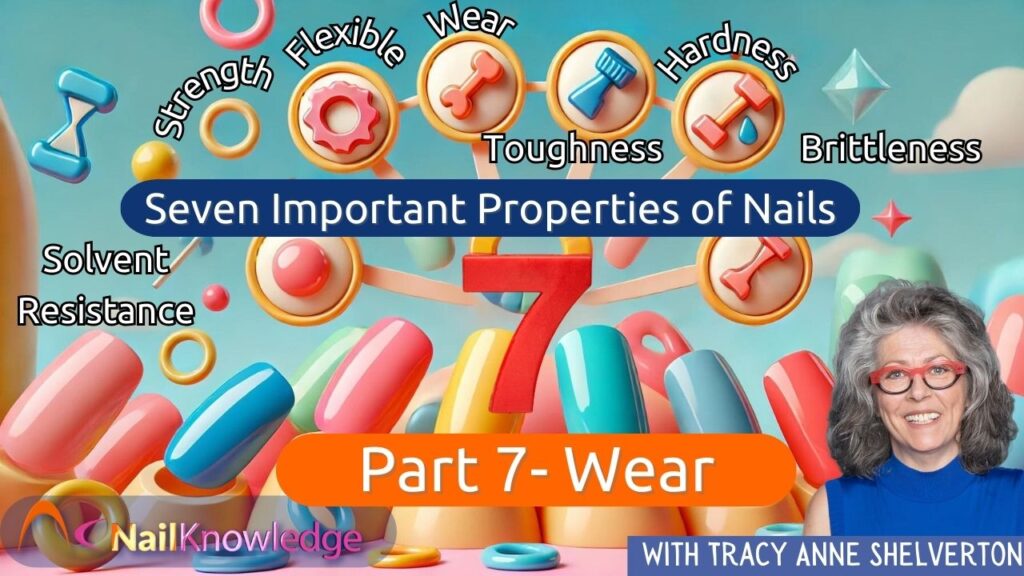In this final part of our series on the key properties of natural and artificial nails, we focus on wear resistance. Wear refers to the ability of a surface to resist abrasion or rubbing over time. As we’ve already explored strength, hardness, flexibility, toughness, brittleness, and solvent resistance, understanding wear is crucial for maintaining the longevity and durability of both natural and artificial nails.
What Is Wear Resistance and Why Is It Important?
Wear resistance describes how well a surface can withstand abrasion or damage caused by rubbing and scraping. For nails, wear resistance ensures that they do not wear away too quickly from daily activities like typing, cleaning, or filing. Both the natural nail plate and artificial nail coatings benefit from wear resistance, as tougher and harder surfaces tend to last longer and maintain their appearance.
Nail plates have a relatively low hardness compared to other materials, largely because they contain a significant amount of water. On the Mohs scale, natural nails have a hardness of 2, while artificial nail coatings typically range between 2 and 3. This means artificial coatings often provide a tougher, more wear-resistant surface than natural nails but when our artificial nail is harder than the natural nail we need to be aware of maintenance and care, it can’t just be hard it also needs to be flexible.
Nail Hardness and Wear Resistance
Nail hardness is a major factor in wear resistance. Harder materials tend to resist abrasion better than softer ones. For example, diamond, which has a hardness of 10, is one of the hardest substances and is often used in high-quality nail files. In comparison, natural nails and most artificial coatings fall far below this level of hardness, meaning they are more susceptible to wear. Silicon carbide, a common material used in nail files, has a hardness of 9, making it nearly as effective as diamond in abrading nail surfaces.
Nail files with high hardness materials, such as diamond grit or silicon carbide, can be overly aggressive if not used carefully. These files can wear down artificial coatings quickly but more so the nail plate, potentially causing excessive thinning and damage. Aluminum oxide, a softer abrasive with a hardness of 7.5, is less aggressive but still significantly harder than natural nails. This makes it an ideal material for nail files because they are gentler on the nails its self but tough enough to do the job well. Almost all Aluminium Oxide files are white but check with your supplier to be sure.
How Abrasives Affect Nail Wear
Abrasive particles in nail files scratch away the surface of the coating to shape and smooth it. For the natural nail, we only need the file to shape the free-edge. A 180 grit Aluminium Oxide Spong File can be used with care to ‘etch’ the surface of a natural nail and also tip to remove any little bits of nail at the free edge (those irritating little bits of nail that can cause so much trouble at the free edge when applying gel polish after filing into shape)
Coarse-grit abrasives with larger particles create deeper and wider scratches, while finer-grit abrasives create smaller and shallower scratches. Heavier grit abrasives can cause excessive thinning of the nail plate, especially if used with heavy pressure. Even buffers, which are meant to etch the nail surface, will cause damage when over excessive pressure is used. Damage done with a nail file on the nail surface cannot be recovered without using an intensive nail recovery system of which there is only one – not recovering the surface of the nail plate will not only disturb the balance of your nail coating but also seriously diminish the wear time.
The wear resistance of nails is closely linked to toughness, as tougher materials tend to resist wear better. Natural nails that are more brittle are at a higher risk of wear, and the solution is often to increase flexibility through treatments such as hot oil applications. This added flexibility helps protect the nails from excessive wear and tear.
Maximizing Wear Resistance for Nail Health
To ensure optimal wear resistance, it’s important to maintain a balance between toughness and flexibility in both natural and artificial nails. For artificial coatings, using products that offer a combination of strength and flexibility can improve wear resistance and longevity. For natural nails, keeping them hydrated and using treatments to enhance flexibility can help prevent wear and damage over time.
In conclusion, wear resistance is the final key property that ensures the durability and health of both natural and artificial nails. By understanding how wear, hardness, and abrasives interact, nail care professionals can make informed decisions to protect their clients’ nails from excessive wear.
Recap of the Seven Key Properties of Nails:
- Nail Strength – Discover how the strength of nails impacts their performance and durability.
- Nail Hardness – Understand the crucial role of hardness in nail health and how to maintain the perfect balance.
- Nail Flexibility – Understand the importance of flexibility in preventing nail breakage and maintaining resilience.
- Nail Toughness – Find out what makes nails tough and how this property differs from strength and hardness.
- Nail Brittleness – Learn what causes brittleness in nails and how to prevent it.
- Nail Solvent Resistance – Explore how nails can resist damage from chemicals and solvents.
- Nail Wear – Understand the factors that affect how well nails withstand regular use and environmental exposure.
By taking the time to understand these seven key properties, you’ll be able to better troubleshoot issues and ensure that natural nails remain healthy and strong, and artificial nail coatings strong and long-lasting.


